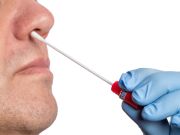FRIDAY, Sept. 25, 2020 (HealthDay News) — People who have COVID-19 but no symptoms have the same amount of virus in their nose and throat as those with symptoms and may play a major role in spreading the disease, a new study reveals.
The researchers compared levels of SARS-CoV-2 in 213 people in South Korea who tested positive for the virus.
Their symptoms ranged from none to severe, including fever, chills, muscle pain, fatigue, runny nose, blocked nose, loss of taste or smell, sore throat, swallowing difficulties, cough, phlegm production, coughing up blood, headache, dizziness, loss of appetite, nausea, vomiting, abdominal pain and diarrhea.
The patients were admitted to a care facility for isolation and monitoring.
Before isolation — an average of six days after the first swab test — 41 patients (19%) hadn’t developed any symptoms. Of those, 39 had another nose and throat swab test an average 13 days after their initial diagnosis.
Of 172 patients with mild symptoms, 144 also were retested. The final analysis included 183 patients in all.
Fifty-four percent of patients without symptoms tested positive for SARS-CoV-2, as did 64% of those with mild symptoms. There was no significant difference in the viral load between the two groups, the researchers said.
The findings were published online Sept. 22 in the journal Thorax. Sung-Han Kim of Asan Medical Center, Songpa-gu in Seoul, South Korea, led the study.
“Considering that most asymptomatic individuals with COVID-19 are likely to go unnoticed by health care workers and continue to reside within communities, such individuals may act as an essential driving force for the community spread of COVID-19 and the ongoing pandemic state,” the study authors concluded.
Until it’s known how infectious people without symptoms are, and for how long, testing should be extended to certain groups as a precautionary measure, the researchers recommended in a journal news release.
“Our data add further support to the general public use of face masks, regardless of the presence of symptoms, and suggest that the scope of SARS-CoV-2 testing should be expanded to include asymptomatic individuals in high-risk settings, such as nursing homes or health care facilities,” Kim said in a podcast that accompanied the findings.
More information
The U.S. Centers for Disease Control and Prevention has more on COVID-19.
Copyright © 2025 HealthDay. All rights reserved.

